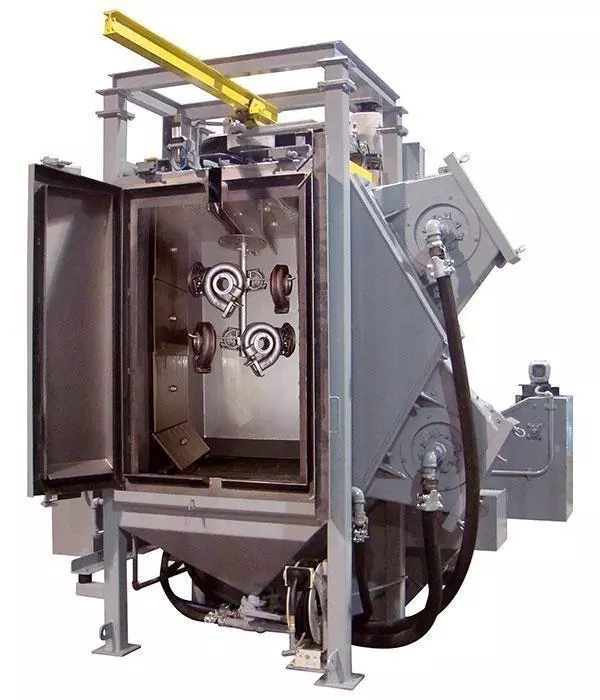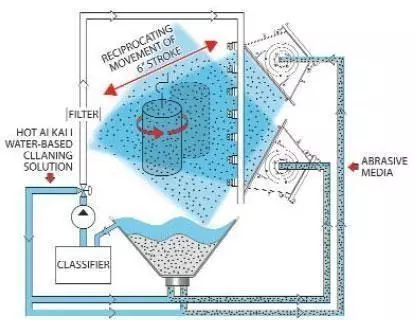Wet Blasting Machine
Industrial manufacturing processes require surface preparation of metal parts to remove oxides, scale, carbon deposits, oils, and grease, among other contaminants, before they are coated, painted, or remanufactured. One of the most efficient and effective methods of cleaning metal parts is slurry blasting technology, also known as wet blasting. Wet blasting employs an abrasive slurry, consisting of abrasive media and a hot water-based alkali cleaning solution, that is mechanically accelerated and discharged at high velocity to clean metal part surfaces. Spinner hanger wet blasting machines are a type of wet blasting equipment that are commonly used in industrial settings to clean metal parts. The machine consists of a blast chamber, spinner hangers, and a slurry delivery system. The spinner hangers are mounted on a rotating carousel and hold the metal parts to be cleaned. The slurry delivery system pumps the abrasive slurry into the blast chamber, where it is mixed with compressed air and mechanically accelerated by a blasting wheel or turbine. The abrasive slurry is then discharged at high velocity onto the metal part surfaces, removing the contaminants and preparing the surface for further treatment.
Benefits of Spinner Hanger Wet Blasting Machine
There are several benefits of using a spinner hanger wet blasting machine for cleaning metal parts. First and foremost, it is a highly efficient and effective cleaning method, removing even the toughest contaminants from metal surfaces. It also provides a consistent and uniform finish, ensuring that all surfaces are cleaned evenly. Additionally, the use of a hot water-based alkali cleaning solution in the slurry helps to prevent flash rusting on the metal surface after cleaning. This is particularly important in industries such as automotive, aerospace, and marine, where metal parts are exposed to harsh environments. Spinner hanger wet blasting machines also offer a high level of automation, which increases productivity and reduces labor costs. The rotating carousel and slurry delivery system can be programmed to clean a large number of metal parts in a short amount of time, allowing for efficient batch processing.Applications of Spinner Hanger Wet Blasting Machine
Spinner hanger wet blasting machines are used in a wide range of industries, including automotive, aerospace, marine, and manufacturing. They are particularly useful for cleaning metal parts that are difficult to clean using traditional methods, such as those with intricate shapes or hard-to-reach areas. In the automotive industry, spinner hanger wet blasting machines are used to clean engine components, transmissions, and suspension parts. In the aerospace industry, they are used to clean turbine blades, engine casings, and landing gear components. In the marine industry, they are used to clean propellers, hulls, and other metal parts exposed to saltwater.
The Spinner Hanger wet Blasting Machine employs a blast wheel to accelerate and discharge the abrasive slurry at high velocity and in a controlled pattern to clean metal part surfaces. The machine's design includes a hook that rotates and reciprocates the loaded part/fixture back and forth to expose all surfaces to the cleaning solution and accelerated abrasive slurry. The combination of rotation and oscillation in front of the wet blast pattern provides even and complete coverage of geometrically complex components. A programmable controller monitors the process and allows for selection of pre-programmed cycle times depending on the parts to be cleaned. The Spinner Hanger wet Blasting Machine comes with several standard features that make it an efficient and effective cleaning system for industrial manufacturing processes.
- Wash, wet blasting, and rinse stages: The machine is equipped with a wash stage, a wet blasting stage, and a rinse stage to ensure that the parts are thoroughly cleaned before they are coated, painted, or remanufactured.
- Straight manual monorail system: The machine's manual monorail system ensures that the parts are loaded onto the holding fixture with ease.
- Simultaneous rotating and horizontal reciprocating hook movement: The machine's hook rotates and reciprocates simultaneously to ensure that all parts' surfaces are exposed to the cleaning solution and accelerated abrasive slurry.
- Roof-mounted variable-speed spinner with dual pneumatic tire friction drive: The machine's roof-mounted spinner provides a variable speed to ensure that the abrasive slurry is discharged at high velocity and in a controlled pattern to clean the metal part surfaces.
- Fully welded cabinet made from sturdy carbon-steel plating: The machine's cabinet is fully welded and made from sturdy carbon-steel plating to ensure durability and longevity.
- Replaceable wear plates inside the blasting cabinet and wheel enclosure: The machine's wear plates are replaceable, ensuring that the abrasive slurry does not cause damage to the blasting cabinet and wheel enclosure.
- Insulated tank and cabinet walls: The machine's tank and cabinet walls are insulated to ensure that the cleaning solution and abrasive slurry remain at the desired temperature for optimal cleaning performance.
- 2 (two), direct-driven bi-directional blast wheels: The machine's bi-directional blast wheels are direct-driven and provide optimal acceleration and discharge of the abrasive slurry.
- Blast wheel speed controlled by variable frequency drives: The machine's blast wheel speed is controlled by variable frequency drives to ensure that the abrasive slurry is discharged at the desired velocity.
- PLC and HMI for programmable processes, machine status and fault warnings: The machine's programmable logic controller (PLC) and human-machine interface (HMI) provide an efficient and user-friendly interface to monitor the cleaning process, machine status, and fault warnings.
- Digital temperature controller: The machine's digital temperature controller ensures that the cleaning solution and abrasive slurry remain at the desired temperature for optimal cleaning performance.
| System Specification | Standard Multi-Stage Wash / wet Blasting / Rinse - SHWB 28 x 36-E |
|---|---|
| Blasting chamber | 1 |
| Maximum workpiece load capacity per hook | 500 lbs |
| Maximum work diameter | 28” |
| Maximum work height | 48” |
| Abrasive load | 500 lbs |
| Hook rotation variable speed | 1 – 4 RPM |
| Hook oscillation speed & stroke | Approx. 2 FPM, 6’’ stroke |
| Wet blasting wheels | Two (2) 13.5’’ dia. |
| Wet blasting wheel motor | 20 hp – 3600 rpm per wheel |
| Main solution tank capacity | 500 USgal |
| Main pump capacity | 115 USgal/min |
| Operating pressure | 70 psi |
| Operating temperature | 140°F max. |
| Machine dimensions W x L x H* | 10’ x 14’3’’ x 11’6’’ |
* For standard wet blasting system. Dimensions vary for systems with Y-track configuration or options.
Options
- Y-track configuration manual monorail
- Exhaust blower
- Exhaust demister
- Drip pan
- Automatic oil coalescer
- Tank access door
- Electric powered hoist
Advantages
- No dust – No need for a dust collector
- Does not require pre- and post-cleaning processes
- Fast cycle time
- Closed-loop process – both detergent and media are recycled
- Does not require compressed air for blast motive force
- Very clean and dust-free part surfaces
- Can process wet, oily, and greasy parts

Part surfaces are free of scale, oil, grease, and rust without any residue normally left by conventional blasting processes.
Cleaning Process
Wash Cycle

Wet Blasting

Rinse Cycle

